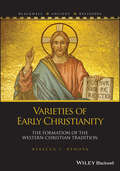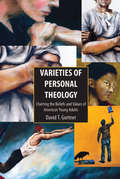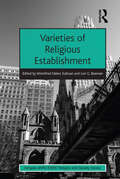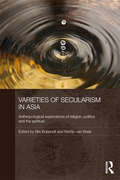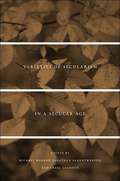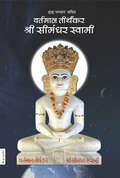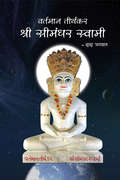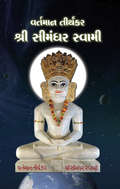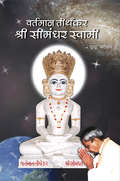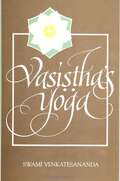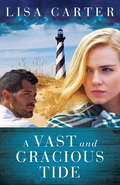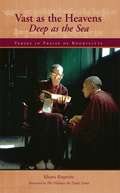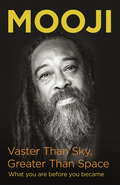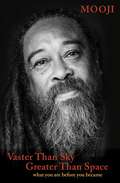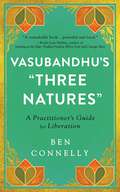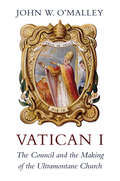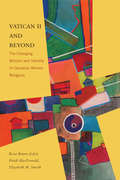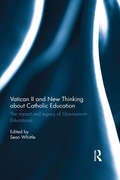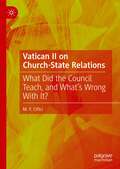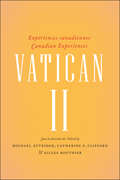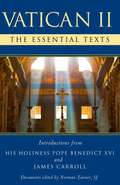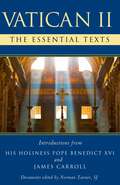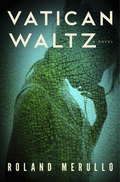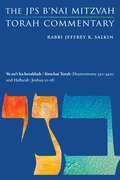- Table View
- List View
Varieties of Early Christianity: The Formation of the Western Christian Tradition (Blackwell Ancient Religions)
by Rebecca I. DenovaProvides a broad and balanced understanding of how Christianity originated in the first five centuries Varieties of Early Christianity: The Formation of the Western Christian Tradition traces the origins and evolution of Christian concepts from the first through the sixth century CE, exploring the events, issues, and individuals that helped shape the beliefs and practices of Christianity. With a multidisciplinary Religious Studies approach, this reader-friendly textbook places the early sources of Christian teaching within their historical and cultural contexts to highlight what gave rise to the beliefs and rituals that Christians follow in the present day. Chronologically organized chapters analyse the ways in which Christians absorbed and adapted ancient concepts from Judaism and Greco-Roman religion and culture from the first through the sixth centuries. Combining both traditions, early bishops, Church Fathers, and theologians added innovations that contributed to the establishment of a unique systematic theology (dogma) that became “Christianity.” Throughout the text, readers are encouraged to consider how the ways early Christians integrated their worldviews, politics, and daily lives can help articulate their own “systems of meaning” in the modern world. Helps readers navigate the vast amount of Christian literature produced in the early centuries of the Church Provides the religious and cultural background of Judaism and Greco-Roman religion and culture, the two major contributors to Christian thought Describes the methodology used to analyze the gospels in relation to ancient literature Explores topics such as Christian martyrs in the Roman Empire, the role of women in Mediterranean society, Gnostic Christians, the Christianization of the Roman Empire, the work of Saint Augustine, and the Council of Chalcedon Includes excerpts from primary documents, definitions of words and concepts, further readings, and numerous figures, timelines, and mapsFeaturing concise analyses of key scholarly and archaeological research, Varieties of Early Christianity: The Formation of the Western Christian Tradition is an excellent textbook for secondary school classes and college undergraduate courses on the history of Christianity, as well as a valuable resource for general readers interested in examining the history of Christian ideas in their historical context.
Varieties of Personal Theology: Charting the Beliefs and Values of American Young Adults
by David T. GortnerVarieties of Personal Theology starts from the premise that all human beings are folk theologians, active not only in constructing selves but also in constructing worlds and guiding philosophies of life.Through fascinating indepth interviews and surveys, David Gortner looks specifically at 'emerging adults' (aged 18-25) as young theologians who, regardless of religious background, wrestle with fundamental questions of place, purpose, ultimate cause, and ultimate aims in life. This book charts the subtle and significant influences of social class, family, school, work, peer relationships, religion, and intrinsic attitudes and dispositions on young adults' personal theologies, and traces the ways their personal theologies connect with choices they make in their daily lives - in education, jobs, leisure, and relationships. Intentionally crossing boundaries between religious and social science fields, Gortner combines perspectives from both to demonstrate how theological diversity persists in America despite some clear culturally dominant trends. This book reveals how American young adults are active theologians forging diverse ways of seeing and being in the world - shaped by their experiences and in turn continuing to shape their choices in life.
Varieties of Religious Establishment (AHRC/ESRC Religion and Society Series)
by Lori G. BeamanAdvocacy for religious freedom has become a global project while religion, and the management of religion, has become of increasing interest to scholars across a wider range of disciplines. Rather than adopting the common assumption that religious freedom is simply incompletely realized, the authors in this book suggest that the starting point for understanding religion in public life today should be religious establishment. In the hyper-globalized world of the politics of religious freedom today, a focus on establishments brings into view the cultural assumptions, cosmologies, anthropologies, and institutions which structure religion and religious diversity. Leading international scholars from a diverse range of disciplines explore how countries today live with religious difference and consider how considering establishments reveals the limitations of universal, multicultural, and interfaith models of religious freedom. Examining the various forms religion takes in Tunisia, Canada, Taiwan, South Africa, and the USA, amongst others, this book argues that legal protections for religious freedom can only be understood in a context of socially and culturally specific constraints.
Varieties of Secularism in Asia: Anthropological Explorations of Religion, Politics and the Spiritual (Anthropology of Asia)
by Martijn Van Beek Nils BubandtVarieties of Secularism is an ethnographically rich, theoretically well-informed, and intellectually coherent volume which builds off the work of Talal Asad, Charles Taylor, and others who have engaged the issue of secularism(s) and in socio-political life. The volume seeks to examine theories of secularism/secularity and examine concrete ethnographic cases in order to further the theoretical discussion. Whereas Taylor’s magisterial work draws up the conditions and problems of a belief in God in Western modernity, it leaves unexplored the challenges posed by the spiritual in modernity outside of the North Atlantic rim. This anthology seeks to begin that task. It does so by suggesting that the kind of secularity described by Taylor is only one amongst others. By attending to the shifting relationship between proper religion and ‘bad faiths’; between politically valorised and embarrassing spiritual phenomena; between the new visibilities and silences of magic, ancestors, and religion in democratic politics, this book seeks to outline the particular formations of secularism that have become possible in Asia from China to Indonesia and from Bahrain to Timor-Leste. This book will appeal to students and scholars of Asian religion, politics and anthropology.
Varieties of Secularism in a Secular Age
by Craig Calhoun Jonathan Vanantwerpen Michael WarnerIn the book a prominent and varied group of scholars chart the conversations in which a secular age intervenes and address wider questions of secularism and secularity.
Vartaman Thirthankar Shree Simandhar Swami: वर्तमान तीर्थंकर श्री सीमंधर स्वामी
by Dada Bhagwanया काळात या क्षेत्रातून सरळ मोक्ष प्राप्ति शक्य नाही’ असे शास्त्रात सांगितले आहे. परंतु दीर्घकाळापासून महाविदेह क्षेत्रात, श्री सीमंधर स्वामींच्या’; दर्शनाने मोक्षप्राप्तीचा मार्ग तर चालूच आहे ना ! संपूज्य दादाश्री त्याच मार्गाने मुमुक्षुंना मोक्षाला पोहोचविण्यात निमित्त आहेत, आणि मुमुक्षुंना ह्या मोक्षप्राप्तीची खात्री निश्चयाने प्रतीत होत असते. या काळात, या क्षेत्रात तीर्थंकर नाहीत, पण या काळात महाविदेह क्षेत्रात वर्तमान तीर्थंकर श्री सीमंधर स्वामी भगवंत विराजमान आहेत,आणि ते भरत क्षेत्रातील मोक्षार्थी जीवांना मोक्ष प्राप्ति करविण्यासाठी प्रबळ निमित्त आहेत. ज्ञानीपुरुष स्वतः त्या मार्गाने प्राप्ति करून इतरांना तो मार्ग दाखवतात. प्रत्यक्ष-प्रकट तीर्थकरांची ओळख होणे, त्यांच्याप्रति भक्तिभाव जागृत होणे, आणि रात्रंदिवस त्यांचे अनुसंधान करून शेवटी त्यांचा प्रत्यक्ष दर्शनाने केवळज्ञान प्राप्त होणे, हाच मोक्षप्राप्तीचा सुरुवातीपासून ते शेवटपर्यंतचा प्रवास (मार्ग) आहे. असे ज्ञानींनी सांगितले आहे. श्री सीमंधर स्वामींची आराधना जेवढी अधिक प्रमाणात होईल तेवढेच त्यांच्यासोबतचे अनुसंधान सविशेष रूपाने होईल. यामुळे त्यांच्याबरोबरचे अनुसंधान प्रगाढ होईल. शेवटी परम अवगाढ दशेपर्यंत पोहोचून त्यांच्या चरणकमळातच स्थान प्राप्तीची मोहोर लागते.
Vartaman Tirthankar Shree Simandhar Swami: वर्तमान तीर्थकर श्री सीमंधर स्वामी
by Dada Bhagwanइस काल में इस क्षेत्र से सीधे मोक्ष पाना संभव नहीं है, ऐसा शास्त्रों में कहा गया हैं। लेकिन लंबे अरसे से, महाविदेह क्षेत्र में श्री सीमंधर स्वामी के दर्शन से मोक्ष प्राप्ति का मार्ग खुला ही हैं। लेकिन परम पूज्य दादाश्री उसी मार्ग से मुमुक्षुओं को मोक्ष पहुँचानें में निमित्त हैं और इसकी प्राप्ति का विश्वास, मुमुक्षुओं को निश्चय से होता ही है। इस काल में, इस क्षेत्र में वर्तमान तीर्थंकर नहीं हैं। लेकिन महाविदेह क्षेत्र में वर्तमान तीर्थंकर श्री सीमंधर स्वामी विराजमान हैं। वे भरत क्षेत्र के मोक्षार्थी जीवों के लिए मोक्ष के परम निमित्त हैं। ज्ञानीपुरुष ने खुद उस मार्ग से प्राप्ति की और औरों को वह मार्ग दिखाया है। प्रत्यक्ष प्रकट तीर्थंकर की पहचान होना, उनके प्रति भक्ति जगाना और दिन-रात उनका अनुसंधान करके, अंत में, उनके प्रत्यक्ष दर्शन पाकर, केवलज्ञान को प्राप्त करना, यही मोक्ष की प्रथम और अंतिम पगडंडी है। ऐसा ज्ञानियों ने कहा हैं। श्री सीमंधर स्वामी की आराधना, जितनी ज़्यादा से ज़्यादा होगी, उतना उनके साथ अनुसंधान विशेष रहेगा। इससे उनके प्रति ऋणानुबंध प्रगाढ़ होगा। अंत में परम अवगाढ़ दशा तक पहुँचकर उनके चरणकमलों में ही स्थान प्राप्ति की मोहर लगती है।
Vartaman Tirthankar Shri Simandhar Swami: વર્તમાન તીર્થંકર શ્રી સીમંધર સ્વામી
by Dada Bhagwanશાસ્ત્રો કહે છે કે આજે આ કાળમાં આપણા આ જગત માંથી સીધા મોક્ષે જવું શક્ય નથી, છતાંપણ હંમેશને માટે લાંબા કાળથી વાયા મહાવિદેહ ક્ષેત્ર ( બીજા ક્ષેત્ર નું જગત ) રસ્તો ખુલ્લો જ છે. તે માટે મહાવિદેહ ક્ષેત્રે જઇ જીવતા તીર્થંકર શ્રી સીમંધર સ્વામીના દર્શન કરવાથી અંતિમ મોક્ષ મળે છે. દાદાશ્રીએ બધા મુક્તિના ઇચ્છુકોને (મુમુક્ષુઓને) પહેલાં આત્મજ્ઞાન આપ્યુંને પછી તેઓ બધા અંતરની પાક્કી ખાતરી સાથે મહાવિદેહના પંથે ચડ્યા છે. આ ધરતી પર આ કાળમાં કોઈ જીવતા તીર્થંકર નથી, પરંતુ અત્યારે મહાવિદેહ ક્ષેત્રમાં તીર્થંકર શ્રી સીમંધર સ્વામી જીવે છે. સીમંધર સ્વામી આ પૃથ્વીના મુમુક્ષુઓને મોક્ષ આપી શકે છે. જ્ઞાનીઓએ આ રસ્તો ફરી ખુલ્લો કર્યો છે અને તેઓ મુમુક્ષુઓને આ રસ્તે મોકલી રહ્યા છે. જીવતા તીર્થંકરને ઓળખી, તેમની પ્રત્યેનો સમર્પણ ભાવ જાગૃત કરી, દિવસ અને રાત તેમની ભક્તિ કરી, તેમની સાથે અનુસંધાન કરી અને અંતે તેમના પ્રત્યક્ષ દર્શન કરી, કેવળજ્ઞાન પ્રાપ્ત કરી મોક્ષે જવાય છે એમ જ્ઞાનીઓ કહે છે. જેમ જેમ સીમંધર સ્વામી પ્રત્યે સમર્પણભાવ વધશે, તેમ તેમ તેમની સાથેનું જોડાણ વધતું જશે અને આ જોડાણથી તેમની સાથે આવતા ભવનું ઋણાનુબંધ બંધાશે. અંતે આ ગાઢ બનેલું ઋણાનુબંધ ભગવાનના ચરણો સુધી પહોંચાડશે અને મોક્ષે લઇ જશે.
Vartman Tirthankar Shree Simandhar Swami (Small): वर्तमान तीर्थकर श्री सीमंधर स्वामी
by Dada Bhagwanइस काल में इस क्षेत्र से सीधे मोक्ष पाना संभव नहीं है, ऐसा शास्त्रों में कहा गया हैं। लेकिन लंबे अरसे से, महाविदेह क्षेत्र में श्री सीमंधर स्वामी के दर्शन से मोक्ष प्राप्ति का मार्ग खुला ही हैं। लेकिन परम पूज्य दादाश्री उसी मार्ग से मुमुक्षुओं को मोक्ष पहुँचानें में निमित्त हैं और इसकी प्राप्ति का विश्वास, मुमुक्षुओं को निश्चय से होता ही है। इस काल में, इस क्षेत्र में वर्तमान तीर्थंकर नहीं हैं। लेकिन महाविदेह क्षेत्र में वर्तमान तीर्थंकर श्री सीमंधर स्वामी विराजमान हैं। वे भरत क्षेत्र के मोक्षार्थी जीवों के लिए मोक्ष के परम निमित्त हैं। ज्ञानीपुरुष ने खुद उस मार्ग से प्राप्ति की और औरों को वह मार्ग दिखाया है। प्रत्यक्ष प्रकट तीर्थंकर की पहचान होना, उनके प्रति भक्ति जगाना और दिन-रात उनका अनुसंधान करके, अंत में, उनके प्रत्यक्ष दर्शन पाकर, केवलज्ञान को प्राप्त करना, यही मोक्ष की प्रथम और अंतिम पगडंडी है। ऐसा ज्ञानियों ने कहा हैं। श्री सीमंधर स्वामी की आराधना, जितनी ज़्यादा से ज़्यादा होगी, उतना उनके साथ अनुसंधान विशेष रहेगा। इससे उनके प्रति ऋणानुबंध प्रगाढ़ होगा। अंत में परम अवगाढ़ दशा तक पहुँचकर उनके चरणकमलों में ही स्थान प्राप्ति की मोहर लगती है।
Vasiṣṭha's Yoga
by Swami VenkatesanandaThis is Swami Venkatesananda's longer Yoga Vasiṣṭha. His two volume book is here offered between two covers. Its purpose is to provide a means to eliminate psychological conditioning and to attain liberation. Containing the instructions of the sage Vasiṣṭha to Lord Rama, this scripture is full of intricately woven tales, the kind a great teacher might tell to hold the interest of a student.
Vast and Gracious Tide
by Lisa CarterA wounded veteran and the police chief's daughter must work together to bring a killer to justiceCaden Wallis lost friends, his girlfriend, and even his leg to the ravages of war. He arrives on the Outer Banks broken and still reeling, struggling to make peace with his new life.McKenna Dockery has been stuck in limbo since her fiancé died three years ago. Now, when the handsome yet heartbroken Caden arrives at her doorstep, she starts to wonder if there may be hope for her heart after all . . .But no sooner do they meet than a man is found murdered on McKenna's property--and Caden is the prime suspect. The two must learn to trust each other, or no one will be safe in the tangled web of conspiracy, greed, and deceit lurking in the tidal marshlands of the Outer Banks.
Vast as the Heavens, Deep as the Sea
by His Holiness the Dalai Lama Gareth Sparham Khunu RinpocheRevered by many--especially His Holiness the Dalai Lama--as the very embodiment of altruism, the late Khunu Rinpoche Tenzin Gyaltsen devoted his life to the development of bodhicitta--the aspiration to achieve enlightenment for the sake of all sentient beings. Presented in both English and the original Tibetan, this modern classic is a collection of Khunu Rinpoche's inspirational verse.
Vaster Than Sky, Greater Than Space
by MoojiIn ever-growing gatherings worldwide, the revered teacher Mooji has opened the eyes of thousands through his rare ability to shine light on the ineffable with uncommon clarity, humour and warmth. Now, in Vaster Than Sky, Greater Than Space, Mooji invites and inspires readers everywhere to discover the true essence from which we all arise. Throughout the book he addresses various questions that come up for seekers, such as: How do I find peace, joy, love and happiness?Is it really possible for an ordinary person with a job and family to attain enlightenment?Are intimate relationships a help or a hindrance to awakening? I don't believe in God, and I don't consider myself a devotional type of person, but the word Truth resonates with me - are your teachings relevant to me?You use the phrase 'timeless presence'. What does it mean? How can anything be timeless? How does one transcend personal conditioning and suppressed emotions, and so come to lasting freedom?If we are essentially free, why does it seem so difficult and distant, so remote or rare to realise the Truth? Through our own earnest search for truth, Mooji helps us arrive at the answers, not by offering concepts but by leading us back to our hidden yet inherent knowing.
Vaster Than Sky, Greater Than Space: What You Are Before You Became
by MoojiIn ever-growing gatherings worldwide, the revered teacher Mooji has opened the eyes of thousands through his rare ability to shine light on the ineffable with uncommon clarity, humor, and warmth. Now, with Vaster Than Sky, Greater Than Space, Mooji invites and inspires readers everywhere to discover the true essence from which we all arise. The Advaita Vedanta tradition teaches that through simple questioning and introspection, we can awaken to something far greater than the ego self, a nondual Oneness with the ground of Being. In Vaster Than Sky, Greater Than Space, Mooji guides us into the adventure of deep inquiry, sparking direct Self-realization through parables, insights, wisdom teachings, and responses to the common questions of readers. Through our own engagement and self-exploration, Mooji helps us to arrive at the answers, not from the limited perspective in which we've been conditioned, but from our own deepest Knowing--revealing the timeless, boundless love and freedom that is the natural perfume of the Absolute.
Vasubandhu's "Three Natures": A Practitioner's Guide for Liberation
by Ben ConnellyIn this book, Ben Connelly shows the power of integrating early Buddhist psychology with the Mahayana emphasis on collective liberation. You&’ll discover how wisdom from fourth-century India can be harnessed to heal and transform systems of harm within ourselves and our communities. The three natures (svabhavas)—the imaginary, dependent, and complete, realized natures—are inherent aspects of all phenomena. The imaginary nature of things is what we think they are. Their dependent nature is that they appear to arise from countless conditions. The complete, realized nature is that they aren&’t as we imagine them to be: things that can be grasped or pushed away. The three natures form the backbone of Yogacara philosophy, and by showing us how to see beyond our preconceived notions of ourselves and others, beyond the things that we&’re convinced are &“true,&” they open up a path to personal and communal healing. Dive into this empowering approach to freedom from suffering, from harmful personal and social patterns, and to finding peace and joyfulness in the present.
Vatican I: The Council and the Making of the Ultramontane Church
by John W. O'MalleyThe enduring influence of the Catholic Church has many sources—its spiritual and intellectual appeal, missionary achievements, wealth, diplomatic effectiveness, and stable hierarchy. But in the first half of the nineteenth century, the foundations upon which the church had rested for centuries were shaken. In the eyes of many thoughtful people, liberalism in the guise of liberty, equality, and fraternity was the quintessence of the evils that shook those foundations. At the Vatican Council of 1869–1870, the church made a dramatic effort to set things right by defining the doctrine of papal infallibility. In Vatican I: The Council and the Making of the Ultramontane Church, John W. O’Malley draws us into the bitter controversies over papal infallibility that at one point seemed destined to rend the church in two. Archbishop Henry Manning was the principal driving force for the definition, and Lord Acton was his brilliant counterpart on the other side. But they shrink in significance alongside Pope Pius IX, whose zeal for the definition was so notable that it raised questions about the very legitimacy of the council. Entering the fray were politicians such as Gladstone and Bismarck. The growing tension in the council played out within the larger drama of the seizure of the Papal States by Italian forces and its seemingly inevitable consequence, the conquest of Rome itself. Largely as a result of the council and its aftermath, the Catholic Church became more pope-centered than ever before. In the terminology of the period, it became ultramontane.
Vatican II and Beyond: The Changing Mission and Identity of Canadian Women Religious
by Elizabeth M. Smyth Rosa Bruno-Jofré Heidi MacDonaldThe year 2015 marked the fiftieth anniversary of the end of the Second Vatican Council, which aimed to align the Church with the modern world. Over the last five decades, women religious have engaged with the council’s reforms with unprecedented enthusiasm, far exceeding the expectations of the Church. Addressing how Canadian women religious envisioned and lived out the changes in religious life brought on by a pluralistic and secularizing world, Vatican II and Beyond analyzes the national organization of female and male congregations, the Canadian Religious Conference, and the lives of two individual sisters: visionary congregational leader Alice Trudeau and social justice activist Mary Alban. This book focuses on the new transnational networks, feminist concepts, professionalization of religious life, and complex political landscapes that emerged during this period of drastic transition as women religious sought to reconstruct identities, redefine roles, and signify vision and mission at both the personal and collective levels. Following women religious as they encountered new meanings of faith in their congregations, the Church, and society at large, Vatican II and Beyond demonstrates that the search for a renewed vision was not just a response to secularization, but a way to be reborn as Catholic women.
Vatican II and New Thinking about Catholic Education: The impact and legacy of Gravissimum Educationis
by Sean WhittleIt is only in the years since Vatican II that the new thinking about Catholic education has crystalised into shape. Vatican II and New Thinking about Catholic Education provides an opportune moment to take stock of the impact of Vatican II on Catholic education. This volume considers the various ways in which Vatican II and its teaching on education has been received and engages with the challenges and testing times that beset faith-based education in the twenty-first century. With insights from an international range of leading and influential advocates of Catholic education, the volume demonstrates the differing contexts of Catholic education and explores the ways in which Vatican II’s teaching on education has been received over the past four or five decades.
Vatican II on Church-State Relations: What Did the Council Teach, and What's Wrong With It?
by M. Y. CiftciShould religion and politics be kept apart? What should be the relationship between the church and the state? M.Y. Ciftci answers these questions by studying the most important event in the recent history of the Catholic Church: The Second Vatican Council (1962-65). The book provides a new interpretation of the Council’s teaching on church-state relations to better appreciate its flaws and need for reform. By paying attention to the (often overlooked) importance given by the Council to the lay apostolate, it reveals how the Council did not reform, as is often thought, but retained a flawed conception of the laity’s role in politics. It then proposes a new framework for understanding church-state relations using the ressourcement method of returning to scripture and tradition, and by a critical dialogue with Oliver O’Donovan and various Protestant biblical scholars of the Powers in the New Testament. Ciftci shows how fruitful an self-consciously ecumenical approach can be for political theology. As most ressourcement theologians have overlooked political issues, and since ecumenical theology rarely touches on issues of church-state relations, this work makes an original contribution to the ressourcement project and to ecumenism.
Vatican II: Expériences canadiennes – Canadian experiences (Religion and Beliefs Series #Vol. 69)
by Attridge, Michael, Clifford, Catherine E & Routhier, GillesLe deuxième concile du Vatican (1961-1965) fut l’un des événements religieux les plus importants du vingtième siècle. Au Canada, il coïncida avec une période de changements culturels et sociétaux sans précédent, entraînant chez les évêques catholiques canadiens un réexamen de la place et de la mission de l’Église dans le monde. Pendant quatre ans, les évêques catholiques canadiens se réunirent avec leurs collègues de partout dans le monde pour réfléchir aux questions urgentes qui se posaient à l’Église et en débattre. Ce livre bilingue étudie l’interprétation et la réception de Vatican II au Canada, analysant diverses questions, dont le rôle des médias, les réactions des autres chrétiens, les contributions des participants canadiens, l’impact du Concile sur la pratique religieuse et sa contribution à la progression du dialogue interreligieux.
Vatican II: The Essential Texts
by Norman TannerBy encouraging engagement with the modern world and a refocusing of traditional teaching, the Second Vatican Council brought new life into the practice of Catholicism. The council's impact on the Church is still playing out today, and with many current church issues finding their roots in differing interpretations of Vatican II it has never lost relevance. Vatican II: The Essential Texts brings together the key documents of the council. As the council is commemorated on its 50th Anniversary, readers will be returning to these source materials to understand the Church's developing positions on its relationship with the secular world and other religions, the role of lay people, human rights and the common good, the liturgy and other still highly relevant issues. In addition to the introductions from Pope Benedict and James Carroll, the documents will also be accompanied by brief historical prefaces from Professor Edward Hahnenberg.
Vatican II: The Essential Texts
by Norman TannerBy encouraging engagement with the modern world and a refocusing of traditional teaching, the Second Vatican Council brought new life into the practice of Catholicism. The council's impact on the Church is still playing out today, and with many current church issues finding their roots in differing interpretations of Vatican II it has never lost relevance. Vatican II: The Essential Texts brings together the key documents of the council. As the council is commemorated on its 50th Anniversary, readers will be returning to these source materials to understand the Church's developing positions on its relationship with the secular world and other religions, the role of lay people, human rights and the common good, the liturgy and other still highly relevant issues. In addition to the introductions from Pope Benedict and James Carroll, the documents will also be accompanied by brief historical prefaces from Professor Edward Hahnenberg.
Vatican Waltz
by Roland MerulloThe new novel from the award-winning author of Breakfast with Buddha and Revere Beach Boulevard tells the story of a young Catholic woman jolted from a quietly devout life in pursuit of a mysterious calling. Cynthia Piantedosi lives a quiet, unassuming life outside of Boston, guided by her Catholic faith. When she loses her beloved grandmother, she begins experiencing "spells" of such intense spiritual intimacy that she wonders about her sanity. Devoted to her elderly father and not particularly interested in dating and socializing, she develops a deep friendship with her parish priest. His congregation sees him as provocative and radical, but he encourages Cynthia to explore her faith--however it presents itself. When he is killed in a mysterious accident, a message begins to emerge from Cynthia's prayers: God is calling her to be the first female Catholic priest. Her revelation is met with ridicule by certain of the more reactionary officials she reaches out to within the Church. Unable to tune out the divine messages, she lets the power of unswerving faith drive her all the way to the Vatican in pursuit of a destiny she doesn't fully understand--and a turn of events that will inevitably bring long overdue change to the Catholic Church.From the Hardcover edition.
Ve-zo't ha-berakhah / Simchat Torah: The JPS B'nai Mitzvah Torah Commentary (JPS Study Bible)
by Rabbi Jeffrey K. SalkinThe JPS B’nai Mitzvah Torah Commentary shows teens in their own language how Torah addresses the issues in their world. The conversational tone is inviting and dignified, concise and substantial, direct and informative. Each pamphlet includes a general introduction, two model divrei Torah on the weekly Torah portion, and one model davar Torah on the weekly Haftarah portion. Jewish learning—for young people and adults—will never be the same. The complete set of weekly portions is available in Rabbi Jeffrey K. Salkin’s book The JPS B’nai Mitzvah Torah Commentary (JPS, 2017).
Vedantic Hinduism in Colonial Bengal: Reformed Hinduism and Western Protestantism (Routledge Studies in Religion)
by Victor A. van BijlertThis book explores the ways in which modern Hindu identities were constructed in the early nineteenth century. It draws parallels between sixteenth and eventeenth Cecntury Protestantism and the rise of modernity in the West, and the Hindu reformation in the nineteenth century which contributed to the rise of Vedantic Hindu modernity discourse in India. The nineteenth century Hindu modernity, it is argued, sought both individual flourishing and collective emancipation from Western domination. For the first time Hinduism began to be constructed as a religion of sacred texts. In particular, texts belonging to what could be loosely called Vedanta: Upanishads and the Bhagavad Gita. In this way, the main protagonists of this Vedantist modernity were imitating Western Protestantism, but at the same time also inventing totally novel interpretations of what it meant to be Hindu. The book traces the major ideological paths taken in this cultural-religious reformation from its originator Rammohun Roy up to its last major influence, Rabindranath Tagore. Bringing these two versions of modernity into conversation brings a unique view on the formation of modern Hindu identities. It will, therefore, be of great interest to scholars of religious, Hindu and South Asian studies, as well as religious istory and interreligious dialogue.
